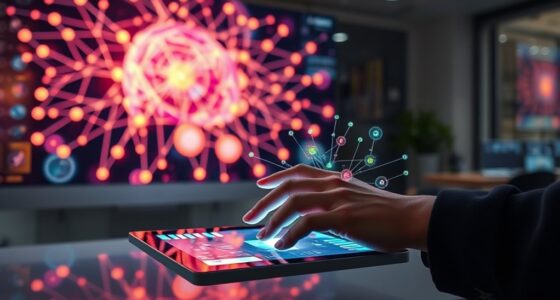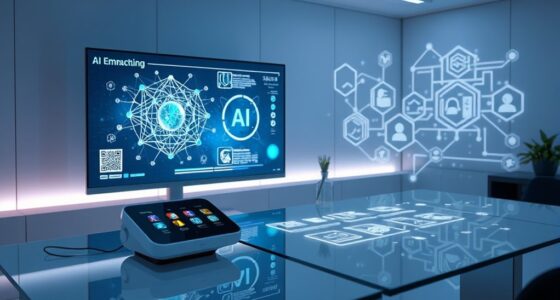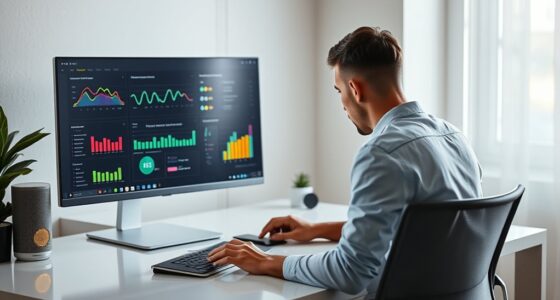AI tracks your digital habits, like email response times, calendar activity, and voice tone shifts, to spot early signs of burnout weeks before you notice them. It monitors changes in your work patterns, such as skipped breaks or decreased collaboration, and even analyzes outside activity for stress indicators. By continuously observing these subtle signals, AI can alert you and your employer early, helping you get support before burnout takes hold. Keep exploring to learn how this innovative approach works.
Key Takeaways
- AI analyzes digital activity patterns like email response times and work hours to spot early signs of fatigue.
- It detects emotional shifts through voice tone analysis and mood monitoring before symptoms become visible.
- Continuous monitoring of work habits identifies deviations such as decreased productivity and skipped breaks.
- AI correlates increased outside activity with declining work performance to anticipate burnout risks.
- Real-time alerts enable proactive interventions, like workload adjustments, before burnout symptoms manifest.

As workplace stress levels rise, AI technology is stepping in to identify early signs of burnout before they become critical. You might not notice the subtle shifts in your mood or energy levels, but AI-powered tools can monitor patterns in your work habits and digital footprint to catch warning signs early. These systems analyze data from emails, calendar activity, computer usage, and even voice tone to spot subtle changes that indicate increasing stress or mental fatigue. Recognizing these signals early empowers you to address issues before they lead to burnout, making mental health awareness a central part of modern workplace culture.
AI’s ability to detect workplace stress hinges on analyzing patterns often invisible to the naked eye. For example, if your email response times slow down, or you start skipping breaks, AI systems can flag these as potential signs of overload. Similarly, a sudden decrease in collaboration or increased error rates could point to mental fatigue. Instead of waiting for you to report feeling overwhelmed, AI provides real-time insights, allowing both you and your employer to take proactive steps. This early intervention can include offering mental health resources, adjusting workload, or encouraging breaks, all aimed at maintaining your well-being before stress escalates.
The key advantage here is that AI doesn’t just react to burnout — it predicts it. By continuously learning your typical work patterns, these systems can identify deviations that suggest rising workplace stress. For example, if your usual productivity drops while your digital activity increases outside of working hours, AI can interpret this as a sign of imbalance. This proactive approach supports mental health awareness by normalizing conversations about stress and burnout, reducing stigma, and fostering a culture of openness. Employers can then use this data to implement targeted wellness programs or adjust policies to better support employee health.
What makes AI so effective is its capacity for early detection without intrusive measures. You’re not subjected to invasive surveys or self-reporting, which can sometimes delay help. Instead, AI quietly monitors digital behaviors and provides alerts to both you and your HR team. This way, you gain insights into your stress levels before they manifest physically or emotionally, giving you a chance to act early. Ultimately, AI’s role in detecting burnout signals emphasizes the importance of mental health awareness, transforming workplaces into safer environments where stress is managed proactively rather than reactively. Additionally, advancements in projector technology demonstrate how innovation can also improve the quality of visual environments, supporting mental well-being through better audiovisual experiences.
Frequently Asked Questions
Can AI Predict Burnout for Remote Employees Accurately?
AI can predict burnout for remote employees quite accurately by analyzing patterns in employee engagement and mental health awareness data. It monitors cues like reduced activity, communication drop-offs, or increased workload, giving you early alerts. This proactive approach helps you support your team better, addressing issues before they escalate. With AI, you gain valuable insights to promote healthier work environments and improve overall well-being, even for remote staff.
How Does AI Differentiate Between Stress and Burnout Signals?
You wonder how AI tells stress from burnout, right? It uses emotional recognition to spot subtle mood shifts and behavioral analysis to observe changes in your work patterns. Stress often shows quick, temporary signs, while burnout reveals persistent emotional exhaustion and disengagement. By analyzing these signals, AI differentiates between fleeting stress and deeper burnout, helping you get the support you need before exhaustion takes over.
What Privacy Measures Protect Employee Data in AI Burnout Detection?
When it comes to protecting your data, AI systems prioritize employee confidentiality by implementing strict privacy measures. Data encryption safeguards your personal information from unauthorized access, ensuring your details stay private. Organizations also enforce access controls and anonymize data to prevent misuse. These measures build trust, allowing you to benefit from early burnout detection without compromising your privacy or sharing sensitive information.
Is Ai-Based Burnout Detection Suitable for All Industries?
AI-based burnout detection isn’t suitable for every industry due to industry-specific adaptations and AI integration challenges. You need to contemplate how different sectors handle employee data and workflow variations. For example, healthcare and finance may face stricter regulations, making implementation more complex. While AI offers valuable insights, you must assess whether the technology aligns with your industry’s unique needs and whether your organization can overcome integration hurdles effectively.
How Often Should AI Monitor Employees for Early Burnout Signs?
Imagine your AI as a nosy coworker, constantly peering over your shoulder. You should let it monitor employees daily or weekly—whatever keeps engagement high and mental health awareness sharp without feeling invasive. Regular checks help catch early burnout signals, ensuring you stay proactive. After all, better to catch the burnout bug early than to wait until everyone’s morale is in the gutter. Balance is key!
Conclusion
By now, you see how AI acts like a crystal ball, spotting burnout signals weeks before you even realize them. It’s like having a trusty squire alerting you to hidden dangers on the horizon, so you can steer clear before it’s too late. Embracing this technology means you’re not just riding the waves of stress but learning to navigate them smoothly. With AI’s help, you’re better equipped to keep your well-being in check—without needing a time machine.









